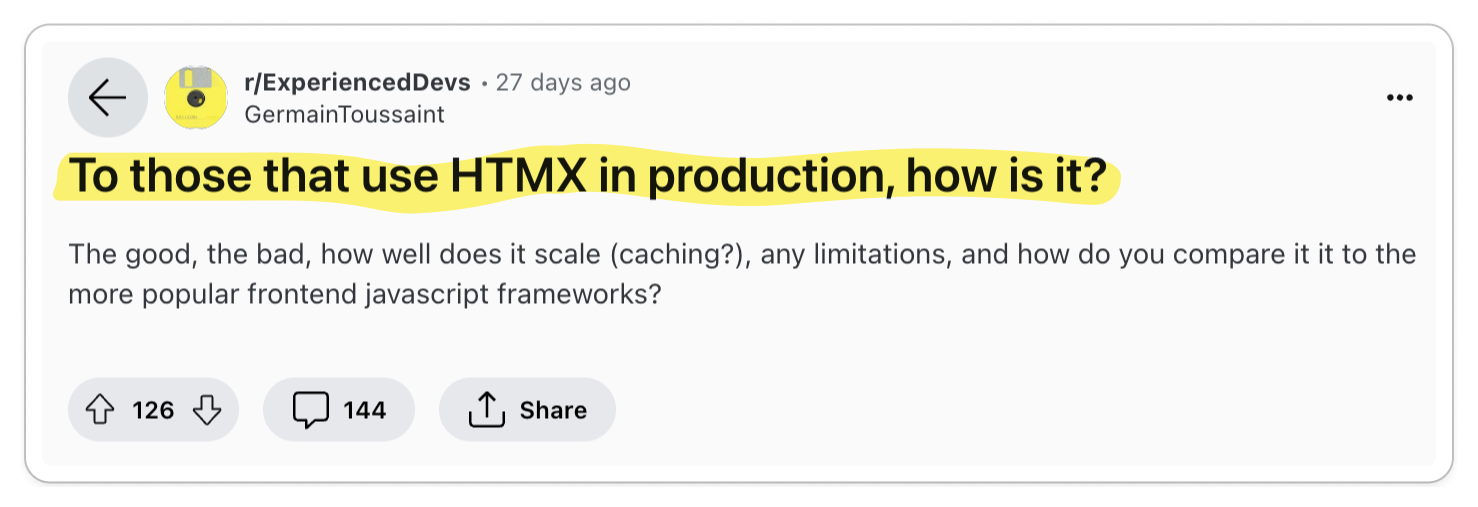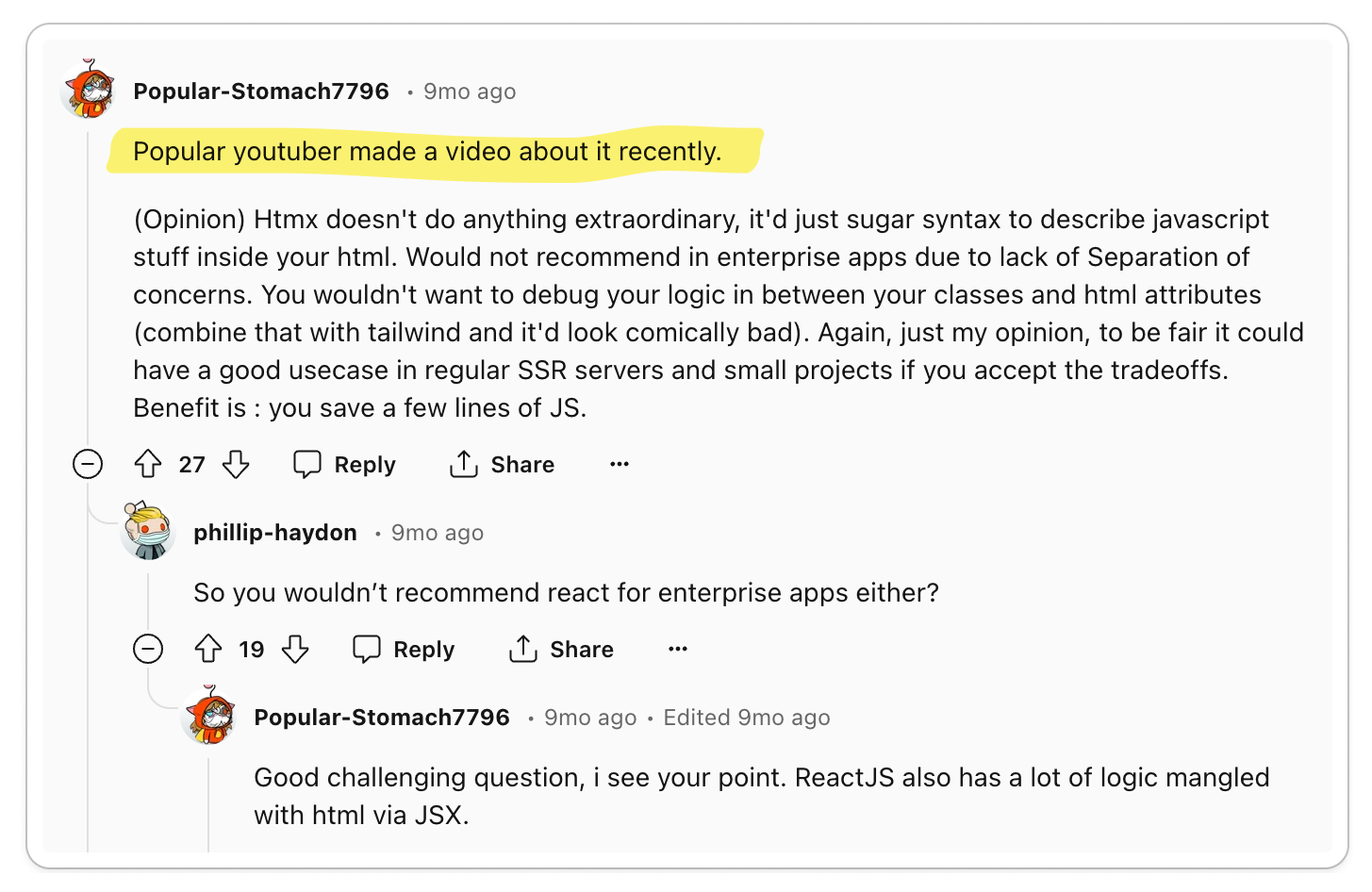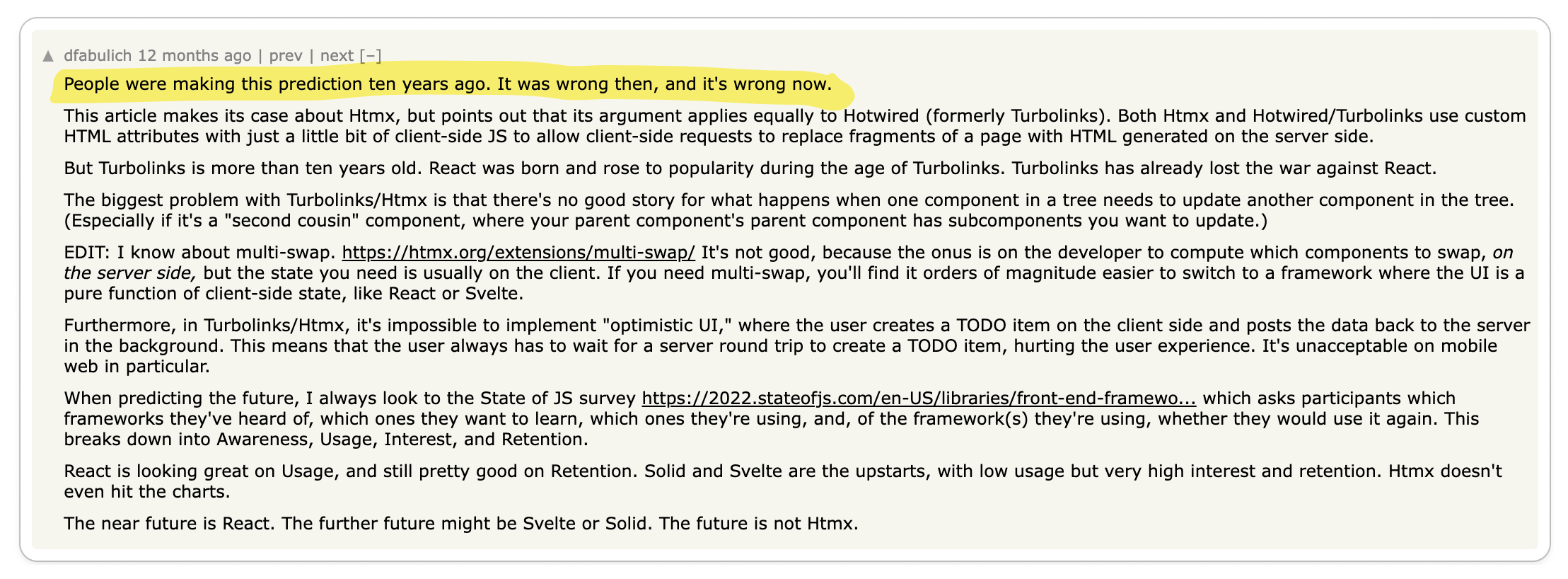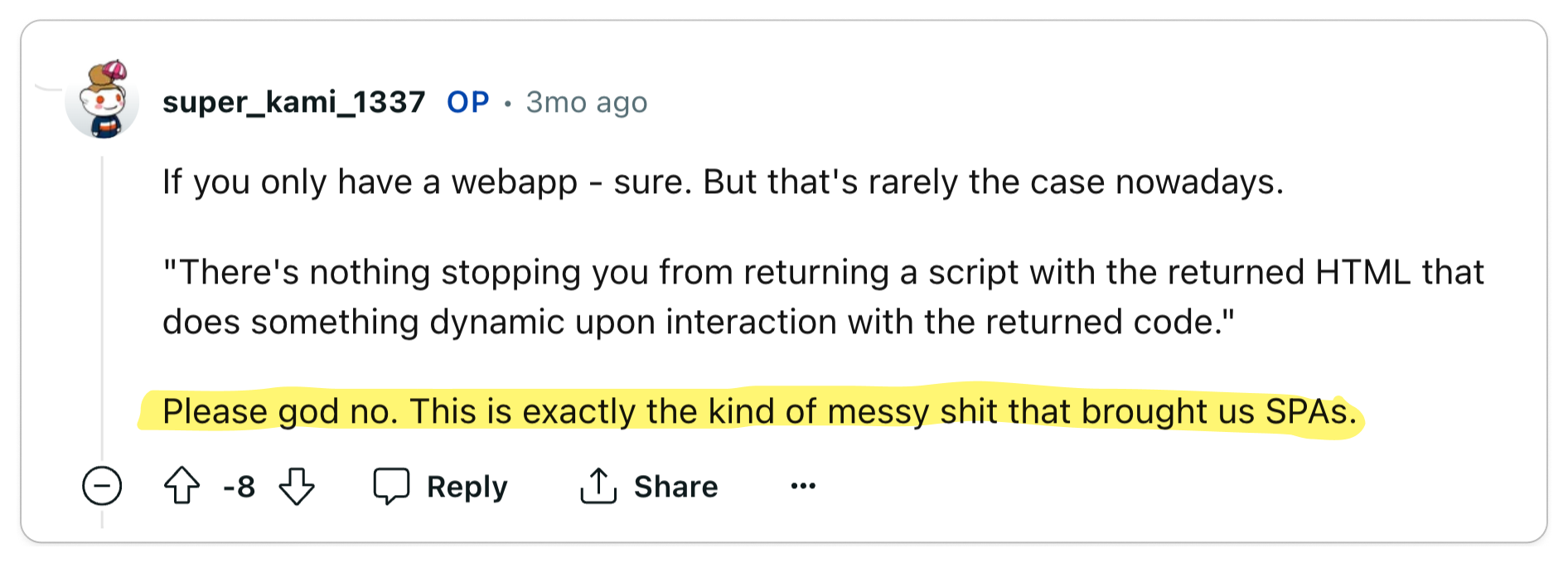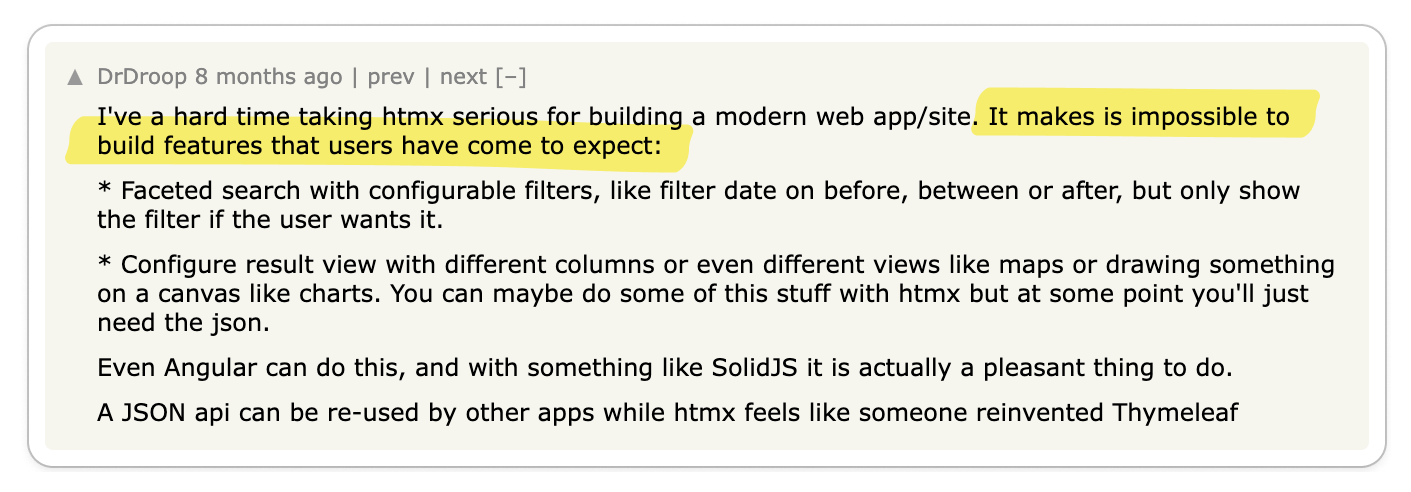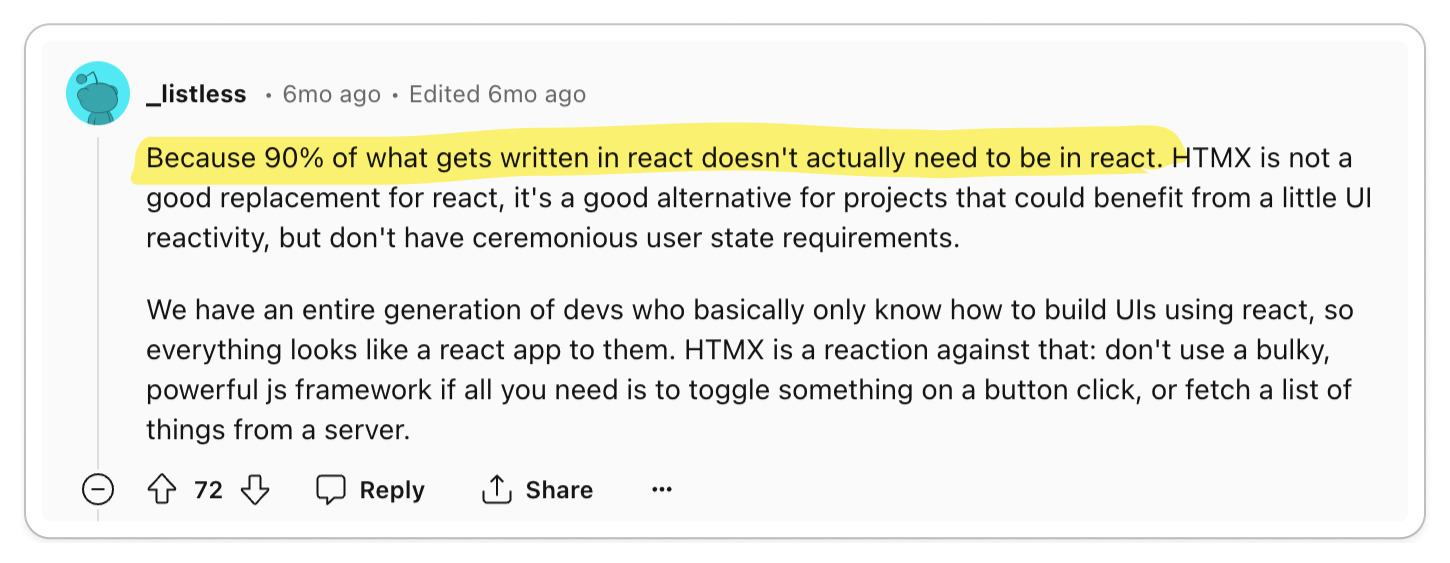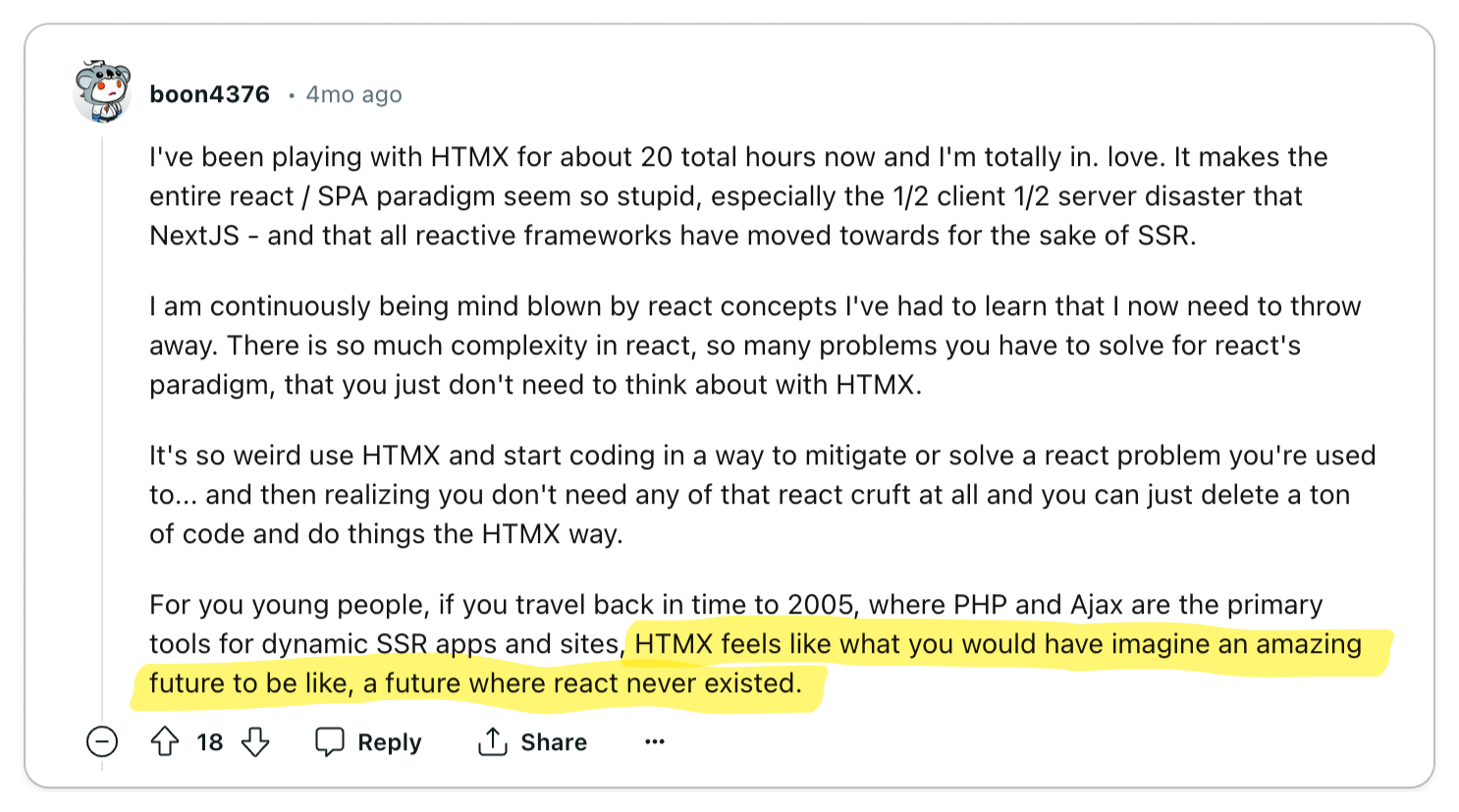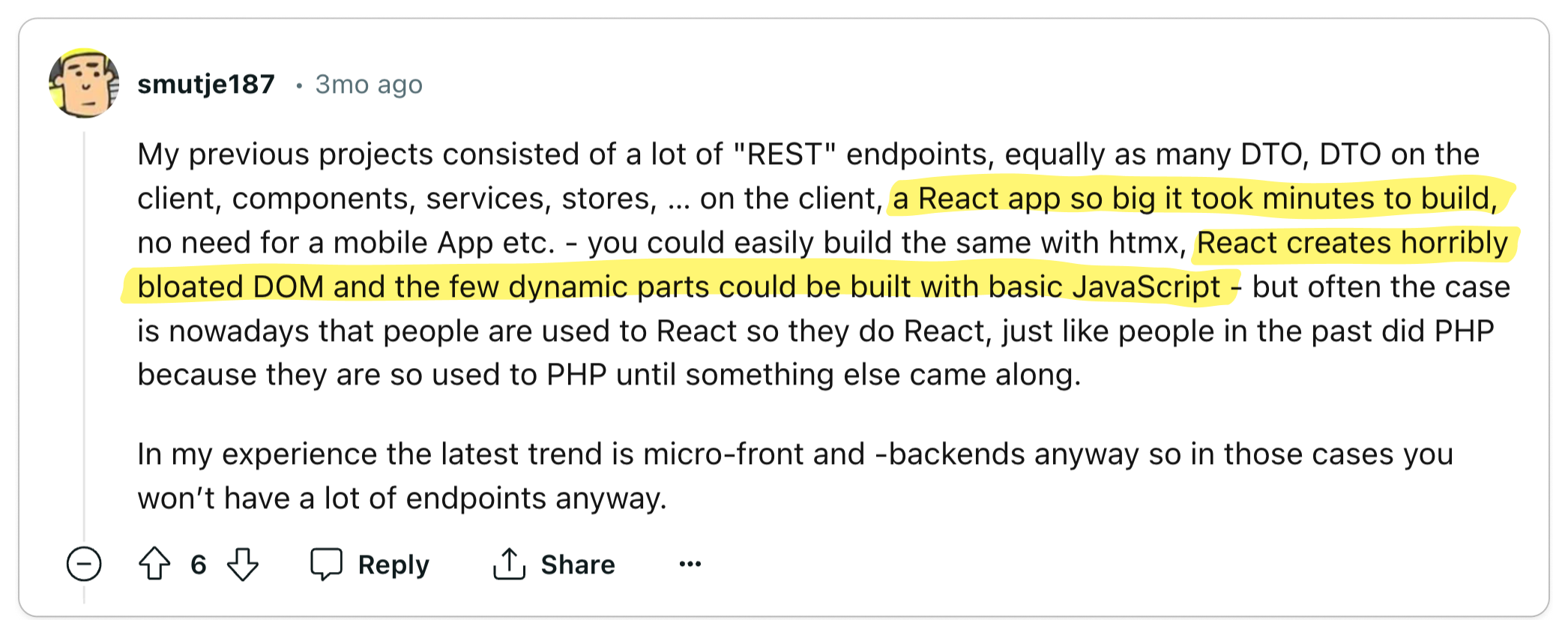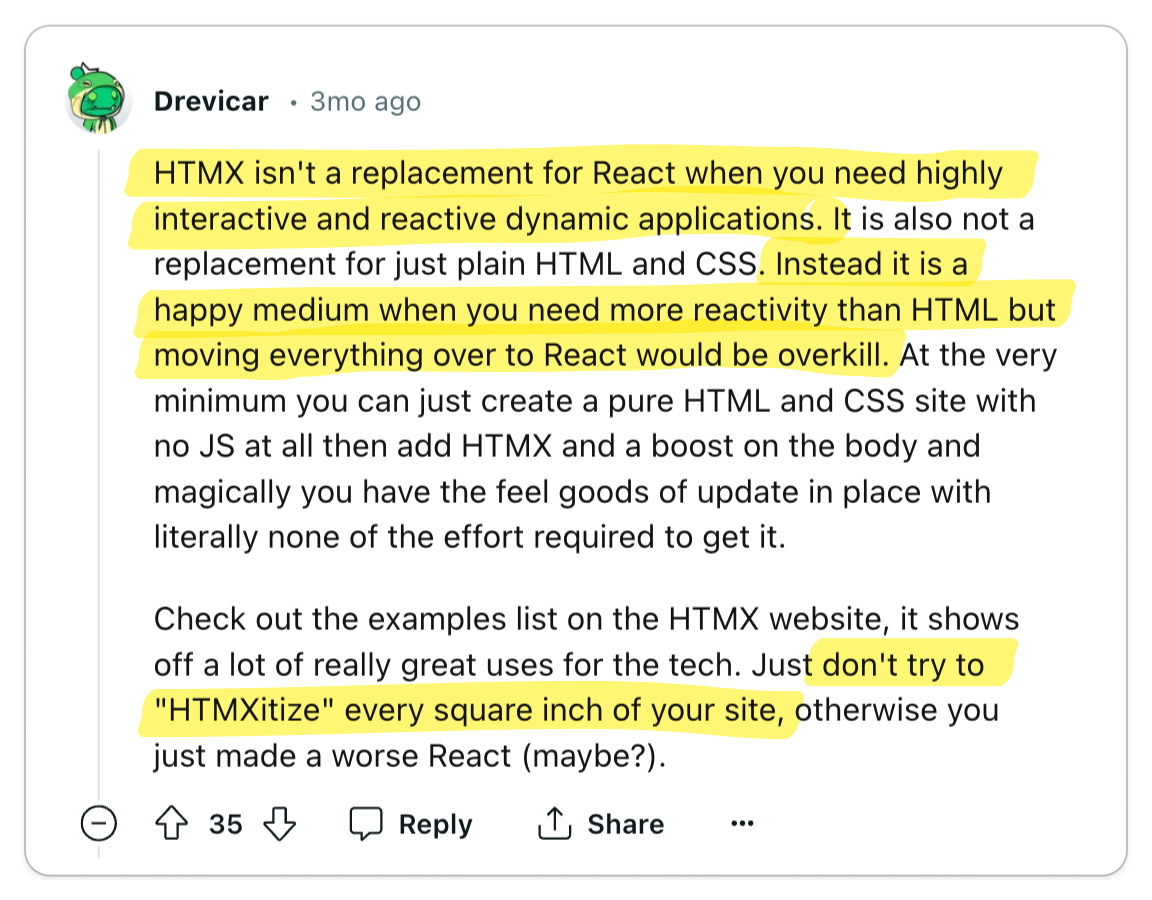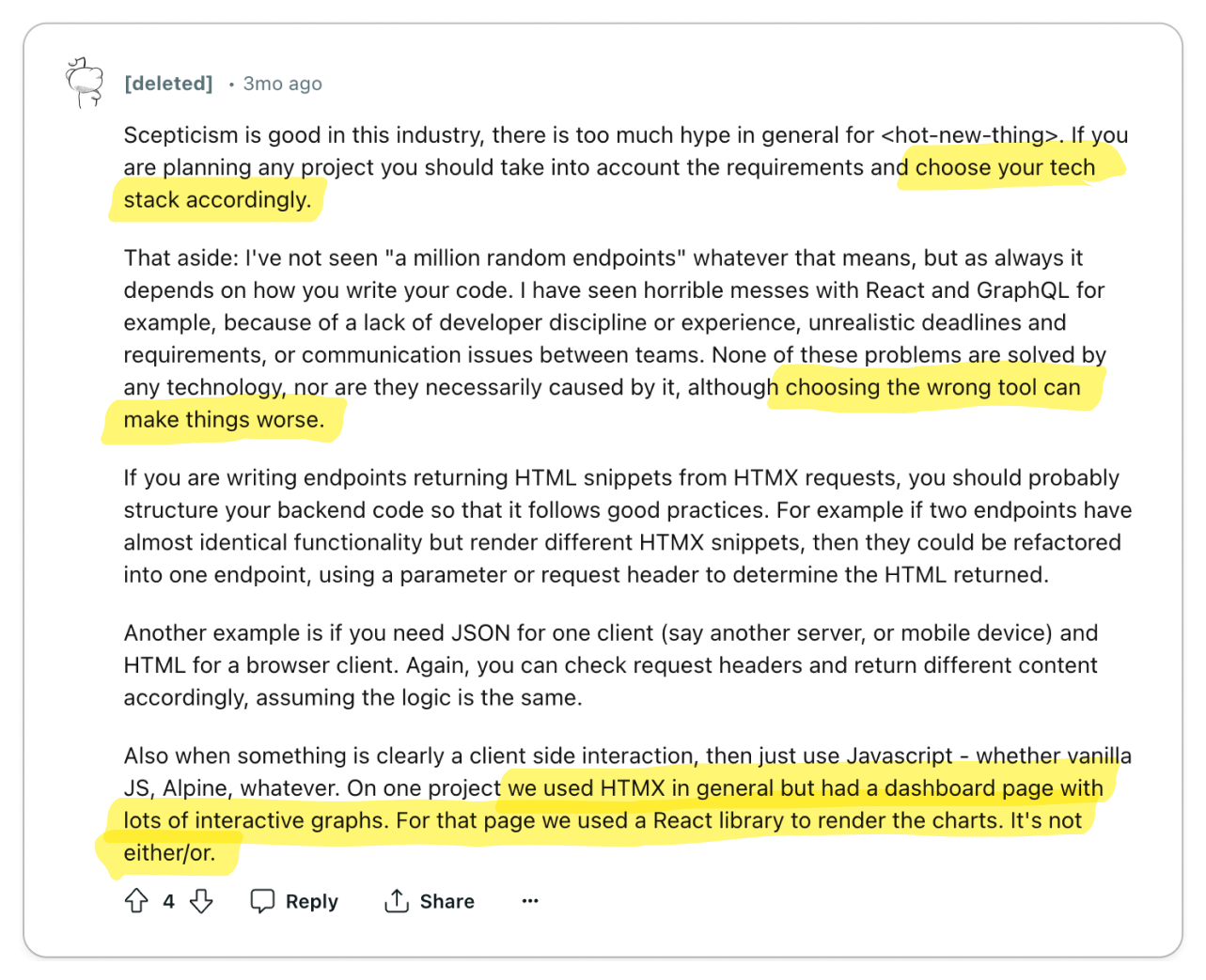
I Reviewed 1,000s of Opinions on HTMX
by Dylan Huang on April 29, 2024
HTMX is a trending JavaScript library that enables the construction of modern user interfaces using hypermedia as the engine of application state.
In a nutshell, you can implement a button that replaces the entire button with an HTTP response using HTML attributes:
<script src="https://unpkg.com/[email protected]"></script>
<!-- have a button POST a click via AJAX -->
<button hx-post="/clicked" hx-swap="outerHTML">
Click Me
</button>
If you follow popular web development trends or are a fan of popular developer-focused content creators, you have probably heard about it through Fireship or ThePrimeagen. However, HTMX has brought an absolute whirlwind of controversy with its radically different approach to building user interfaces. Some folks are skeptical, others are excited, and others are just curious.
To analyze how developers truly feel about HTMX, I went to where developers live: Reddit, Twitter, Hacker News, and YouTube. I parsed 1,000s of discussions and synthesized my findings in this article, striving to present only thought-provoking opinions.

Next, I transcribed these discussions onto a whiteboard, organizing them into "Pro-HTMX" (👍), "Anti-HTMX" (👎), or "Neutral" (🧐) categories, and then clustering them into distinct opinions. Each section in this post showcases an opinion while referencing pertinent discussions.
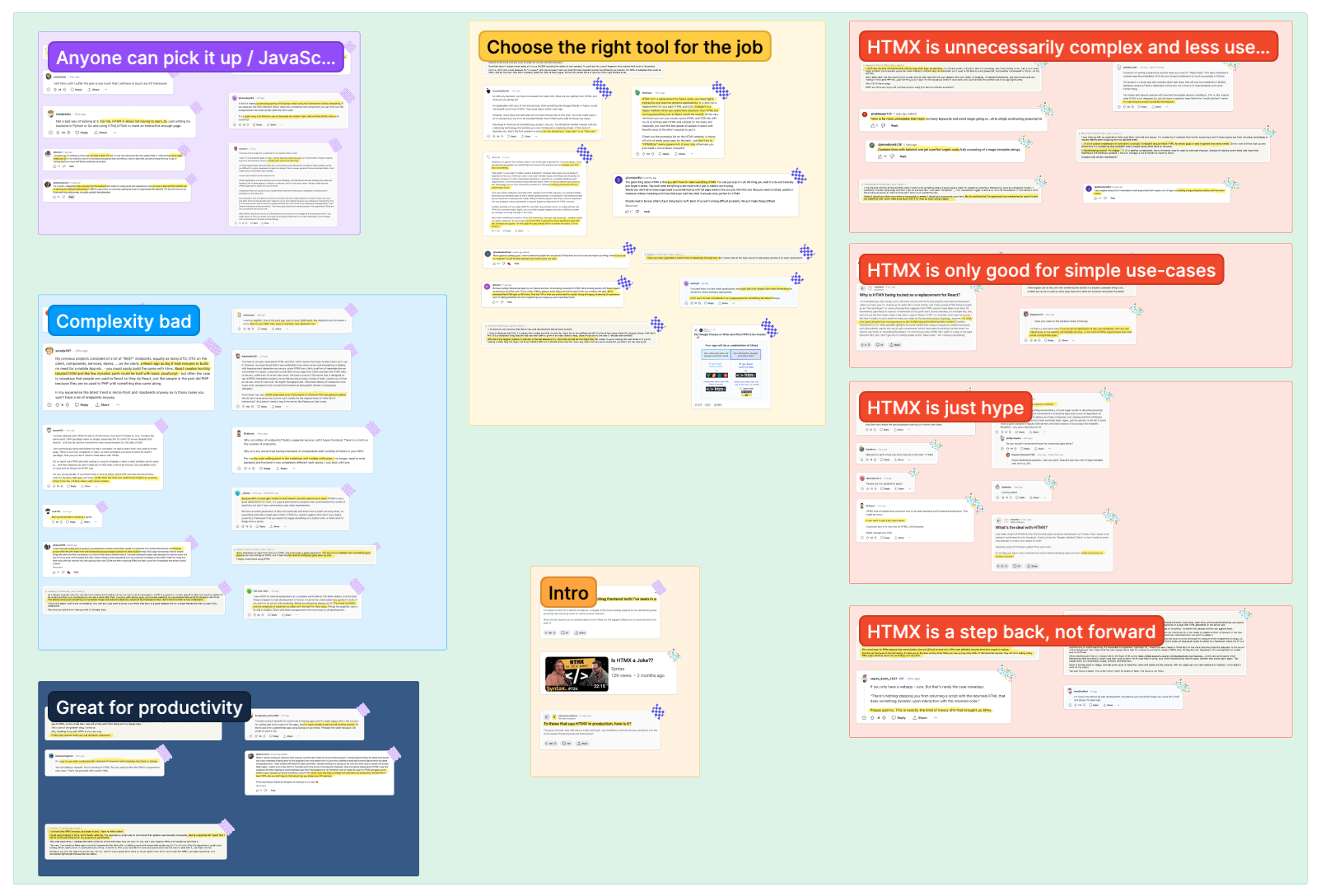
To start, i'll go over the Anti-HTMX (👎) opinions since they are spicy.
👎 HTMX is just hype
After Fireship released a video about HTMX, HTMX started to gain a lot of attention for its radical approach to building user interfaces. Carson Gross, the author of HTMX, is also adept at generating buzz on his Twitter. And since HTMX is new, its unlikely that you will find a lot of examples of sufficiently complex applications using HTMX. Therefore, some developers are of the opinion that HTMX is merely capitalizing on hype rather than offering a genuine solution to the challenges of building user interfaces.
Takeaway
Like all technologies, there is typically a cycle of hype, adoption, and dispersion. HTMX is no different. This cycle is beginning to unfold, and it's time to see what the future holds. It is fair to criticize HTMX for riding a wave of hype. However, if developers feel HTMX is solving a real problem and adopting it accordingly, then adoption will naturally occur. But only time will tell...
👎 HTMX is a step back, not forward
If you squint at HTMX, it looks like a relic of the past where MPA (Multi-page Applications) were the norm. Some developers see HTMX as a step back, not forward. There is a good reason why modern web applications are built using technologies like React, Next.js, and Vue.js. To ignore this, and use HTMX, you might be ignoring the modern best practices of building web applications.
Takeaway
Depending on your level of expertise in building with modern web technologies, you may feel that HTMX is a step back, not forward—especially if you have previously built MPAs with jQuery. For those who see HTMX as a step back, they want nothing to do with it.
If you are already familiar with modern web technologies, your teammates are as well, and current applications are using the latest web technologies, it's really hard to see why you would use HTMX in future applications. But for those starting new applications, HTMX is simply a different approach to building interfaces. Whether it is worth considering depends on the complexity of your application's interface and the expertise of your team. But it definitely doesn't hurt to entertain new ideas like HTMX. Who knows, it could ultimately improve your skills as an engineer.
👎 HTMX is unnecessarily complex and less user-friendly
In practice, some developers feel that HTMX is actually more complex than the current best practices. They specifically dislike the use of HTML attributes, magic strings, and magic behavior. Moreover, some developers feel this make engineerings teams less productive and codebases more complex.
Takeaway
People will always have a natural aversion to unfamiliar technologies, and HTMX is no exception. Those who adopt HTMX in their projects will likely encounter some friction, which could be a source of frustration and negative discourse. HTMX also uses more declarative paradigms, which can be harder to read for developers who are just beginning to learn HTMX. This makes HTMX more complex and less user-friendly for those sorts of developers.
React involves more in-memory state management on the client, while HTMX, on the other hand, embeds state in HTML itself. This is a fundamentally new approach to interface design, which developers would need to learn and adopt before feeling comfortable reading and programming with HTMX.
👎 HTMX is only good for simple use-cases
Users expect modern interfaces which require more complex DOM manipulations and UX design. To implement such interfaces, using HTMX is not enough. Therefore, HTMX is only good for simple use-cases.
Takeaway
For developers that are working on more complex use-cases, HTMX is not enough. And since HTMX has sort of compared itself to React, it is fair to point out that HTMX is not a solution for building complex web applications.
Before deciding to use HTMX, developers should first consider the complexity of the use-case. If HTMX is not the right tool for the job, then look elsewhere for libraries that will allow you to solve the problem. It may well be the case that your use-case will require a "thick client".
👍 HTMX is simple
Developers are witnessing a reduction in codebase complexity and a decrease in overall development time. As grug puts it, "complexity is bad". Developers who embrace this mindset are highly enthusiastic about HTMX. With HTMX handling the DOM manipulations, developers can deduplicate logic from the browser to the server. This marks a significant improvement over the current best practices for building web applications, where a lot of logic needs to be duplicated in the server and client. For backends that are not written in JavaScript, the current standard UI libraries can be a significant burden on the developers of the application.
Takeaway
Simplicity is a subjective concept. It highly depends on your application, team, and use-cases. For those who have spent a lot of time with JavaScript, HTMX stands out for its simplicity. If you feel that the current best practices are overbuilt, bloated, and overly complex—HTMX might be worth considering.
In many use-cases where the primary value of the application lies in the backend, React may not be essential but could still be the optimal choice for your team, depending on their expertise.
👍 HTMX does not require you to know JavaScript
If you are a backend developer, it's unlikely that you know React, JavaScript, or meta frameworks like Next.js. Full-stack developers, on the other hand, may find HTMX to be a breath of fresh air in the form of a simple way to build interfaces. The fact that pretty much any developer can pick up HTMX is a huge benefit, especially for teams that are not as comfortable with JavaScript.
Takeaway
I personally love this perspective and it's actually one of the reasons I've spent some time experimenting with HTMX. My company is a small team and not all of us have used React or Next.js, so HTMX as a solution for teams that are not as comfortable with JavaScript is an extremely compelling narrative for me.
I believe this is true for many other teams as well, especially since full-stack developers are hard to come by. Some developers are finding that this unlocks new opportunities for them to work on interesting projects.
👍 HTMX makes you productive
HTMX, when combined with battle-tested templating libraries like Django's template language or Go's templ library, boosts productivity. By not having to spend time writing a client-layer for the UI, developers can focus on where the application is providing most of the value, which is the business logic. This is especially effective when paired with
Takeaway
By reducing the amount of redundant business logic in the client-layer,
developers are finding that they can focus on the actual product and not the UI.
And since you can get up and running with HTMX with a simple <script> tag, it's
easy to bootstrap a project with HTMX.
These two factors leave a positive impression on the developer experience for some.
🧐 HTMX is not a silver bullet
Like any problem, you must choose the right tool for the job. For developers who see HTMX for its pros and cons, they believe that it's just another tool to solve a specific problem. And since HTMX can also be progressively adopted, developers can adopt it in small portions of their codebase. But as always, certain use-cases will require more complex client logic which would require you to reach for more advanced tooling like React.
Takeaway
Like everything else in software, choose the right tool for the job. It's not much of a takeaway, but consider it your responsibility as an engineer to make critical decisions, such as whether or not to adopt HTMX.
Conclusion
Competition is good. HTMX is thought-provoking, but I think its great because it forces developers to entertain new and novel ideas. Developers can often be wary and cautious of new technologies, since it might not be solving a personal problem they are already facing. But for the developers that are resonating with HTMX, there is an enthusiastic group of developers who are starting to use it in production.
I have not personally deployed a production application using HTMX, but I am really excited to try it. It would solve a personal problem with my engineering team and also allow me to simplify the build process of deploying applications. Those two things are important to me, and HTMX seems like a great fit.


